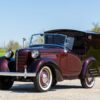Few manufacturers in history have demonstrated as much faith in their product as Roy Evans did. Despite the initial failure of the tiny American Austin in 1934, Evans refused to throw in the towel. By 1937, he unveiled a revamped and modernized version, the American Bantam, which began rolling off the factory line in Butler, Pennsylvania. Working with renowned racing engineer Harry Miller, Evans enhanced the car’s basic 50-cubic inch, four-cylinder engine. Additionally, the Bantam’s design received a contemporary makeover by the skilled hands of Count Alexis de Sakhnoffsky, earning him $300 for his services.
The Bantam, like its predecessor, the Austin, was truly ahead of its time. Despite being small and incredibly economical, with an undeniable charm, these qualities didn’t resonate with buyers in the late 1930s. Sadly, production ceased in 1941 after fewer than 7,000 units were produced. Ironically, it was only during the days of rationing that many came to appreciate the fuel-efficient little runabouts. In its final months, the company left a lasting impact by developing a small prototype military vehicle, later mass-produced by Ford and famously known as the jeep.
Today, Bantams have garnered a dedicated following among enthusiasts, supported by an active club. They consistently bring the most “smiles per mile” to any collector car event.
Photo Source: RM Sotheby’s













